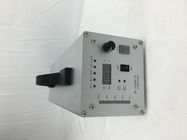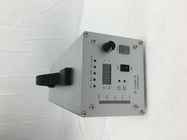
loading


| Quantity: | |
| Place of Origin | China |
|---|---|
| Brand Name | RPS-SONIC |
| Certification | CE |
| Model Number | RPS-2000 |
| Minimum Order Quantity | 1set |
| Price | negotiation |
| Packaging Details | FOAM AND CARTON |
| Delivery Time | 3DAYS |
| Payment Terms | T/T, Western Union, MoneyGram |
| Supply Ability | 200 SETS PER MONTH |
| Frequency | 15K~60K | Power | 300W~3000W |
|---|---|---|---|
| Type | Digital Generator | Size | 120*120*380 |
| Weight | 3.3Kg | Certification | SGS |
| High Light | digital ultrasonic generator,ultrasonic frequency generator | ||
Power Supply. Every ultrasonic welder starts with a power supply. The power supply is sometimes referred to as the frequency generator because it takes standard electrical power (usually 115V) at 60 Hz and converts it to the operating frequency of approximately 20 kHz or 20,000 cycles per second. Other output frequencies commonly available range from 15-70 kHz. This high frequency current is then sent through a special cable to the ultrasonic stack.
Ultrasonic Stack. The stack is not one thing, but rather the combination of three core components: the converter, booster, and weld horn. In a plastic welder, the ultrasonic stack is aligned vertically and sits above the parts being welded in a supported column.
This digital generator is available in frequencies of 15kHz, 20Khz, 28Khz,30 kHz, 35 kHz and 40Khz at a power range between 300 W and 3000 W. Programmable ramp up and ramp down times and infinitely variable adjustment of weld amplitudes are only some of the features of this product line. The biggest advantage of this generator is the wide frenquncy range, for example: the 20Khz generator, it can catch the frequency from 18~21khz, so it is easy to tuning. Also it is easy for some ultrasonic new user.
100% digital control of all power supply functions and parameters allows for unique configurations and future upgrades or requirements. Includes digital frequency syntheses
Industry leading data acquisition rate speed of .5 ms due to advanced multi-core architecture. Increased weld accuracy and repeatability.
Advantages
1. DDS and PID high precision frequency control core.
2. Electric constant amplitude control system.
3. Welding amplitude setting range 0% - 100% by 1%.
4. Soft start, setting range 0-999MS, setprecison 1MS.
5. Three self-checking modes.
6. Pressure trigger/Time/Energy welding modes.
7. Six protections.
8. Less space, total weight 3.3KG.
| Ultrasonic generator technical specification | |||||||||
| Model | 15kHz | 20 kHz | 30 kHz | 35 kHz | 40 kHz | ||||
| Operating environment | -20℃~+80℃, humidity less 70% | ||||||||
| Dimension | Length 350mm, Width 12mm, Height 100mm | ||||||||
| Matched converter | 15kHz | 20kHz | 30kHz | 35kHz | 40kHz | ||||
| Power | 2200W/3200W | 2000W/2600W | 800W/1500W | 800W/1200W | 500W/800W | ||||
|
Material | Shell: aluminum alloy,
Panel: 304 stainless steel, Heating panel: 6061 pure aluminum | ||||||||
| Voltage | 220VAC, 50/60HZ | ||||||||
| Standard parts | Ultrasonic generator, converter wire, power wire, control signal interface, DB9 core wire. | ||||||||
| Optional part | Shockproof suitcase | ||||||||
Sonic & ultrasonic transducers are electro-mechanical or electro-acoustic converters. They transform electric energy into vibrations, which are used to generate mechanical, acoustic or even thermal power. Sonic transducers operate at audible frequencies, while ultrasounds operate at 20kHz or above. Transducers are often reciprocal devices: Most transducers can operate as sensors or generators exploiting mecano-electric conversion. This section introduces only actuation or emission modes. Conversion in such transducers is generally based on piezoelectric, magnetostrictive or magnetic forces.
The most conventional approach consists in using such forces to excite a mechanical resonance. For the same electric excitation, the vibration at resonance is the low frequency vibration multiplied by the mechanical Quality factor at resonance. This allows to achieve a good efficiency and reduced excitation voltages. The alternative way is to generate forced vibrations. Forced vibrations lead to large frequency bandwidth and are much less sensitive to load variations.
The usual ultrasonic transducers also called industrial ultrasonic processors are resonant structures typically based on 3 half-wave length resonators : a piezo converter, a booster and a sonotrode. They are used for ultrasonic welding, milling, cleaning, nebulization or ultrasonic assistance in drilling, extrusion, homogeneisation, filter declogging…HC-SONIC can define solutions using standard transducers. Customisation is often required to adapt the sonotrode to the load as shown below.
A new approach consists in using new active materials such as multilayer piezo ceramics (MLA) or giant magnetostrictive materials (GMM). These are used to build low frequency resonant transducers in dual-mass Tonpilz structures.
| Application | Suitable |
| Welding | Available |
| Sealing | Available |
| Sewing | Available |
| Cutting | Available |
| Sonochemistry | Available , but not the best, If open the equipment when the horn in the liquid , it can catch the frequency well, it is better tracking the frequency without any loading. |
| Metal welding | Available , but not the best. Metal welding always in high loading , it is better use a generator with well ventilation. |
| Atomization | Available |
The power input standard is: single-phase AC220V 50HZ/60HZ.
Input power supply voltage fluctuation range: <10%.
Input power supply harmonic content: <20%.
Input power supply current: 10A.
Input power cord diameter: >1.5MM2.
| Frequency | 15K~60K | Power | 300W~3000W |
|---|---|---|---|
| Type | Digital Generator | Size | 120*120*380 |
| Weight | 3.3Kg | Certification | SGS |
| High Light | digital ultrasonic generator,ultrasonic frequency generator | ||
Power Supply. Every ultrasonic welder starts with a power supply. The power supply is sometimes referred to as the frequency generator because it takes standard electrical power (usually 115V) at 60 Hz and converts it to the operating frequency of approximately 20 kHz or 20,000 cycles per second. Other output frequencies commonly available range from 15-70 kHz. This high frequency current is then sent through a special cable to the ultrasonic stack.
Ultrasonic Stack. The stack is not one thing, but rather the combination of three core components: the converter, booster, and weld horn. In a plastic welder, the ultrasonic stack is aligned vertically and sits above the parts being welded in a supported column.
This digital generator is available in frequencies of 15kHz, 20Khz, 28Khz,30 kHz, 35 kHz and 40Khz at a power range between 300 W and 3000 W. Programmable ramp up and ramp down times and infinitely variable adjustment of weld amplitudes are only some of the features of this product line. The biggest advantage of this generator is the wide frenquncy range, for example: the 20Khz generator, it can catch the frequency from 18~21khz, so it is easy to tuning. Also it is easy for some ultrasonic new user.
100% digital control of all power supply functions and parameters allows for unique configurations and future upgrades or requirements. Includes digital frequency syntheses
Industry leading data acquisition rate speed of .5 ms due to advanced multi-core architecture. Increased weld accuracy and repeatability.
Advantages
1. DDS and PID high precision frequency control core.
2. Electric constant amplitude control system.
3. Welding amplitude setting range 0% - 100% by 1%.
4. Soft start, setting range 0-999MS, setprecison 1MS.
5. Three self-checking modes.
6. Pressure trigger/Time/Energy welding modes.
7. Six protections.
8. Less space, total weight 3.3KG.
| Ultrasonic generator technical specification | |||||||||
| Model | 15kHz | 20 kHz | 30 kHz | 35 kHz | 40 kHz | ||||
| Operating environment | -20℃~+80℃, humidity less 70% | ||||||||
| Dimension | Length 350mm, Width 12mm, Height 100mm | ||||||||
| Matched converter | 15kHz | 20kHz | 30kHz | 35kHz | 40kHz | ||||
| Power | 2200W/3200W | 2000W/2600W | 800W/1500W | 800W/1200W | 500W/800W | ||||
|
Material | Shell: aluminum alloy,
Panel: 304 stainless steel, Heating panel: 6061 pure aluminum | ||||||||
| Voltage | 220VAC, 50/60HZ | ||||||||
| Standard parts | Ultrasonic generator, converter wire, power wire, control signal interface, DB9 core wire. | ||||||||
| Optional part | Shockproof suitcase | ||||||||
Sonic & ultrasonic transducers are electro-mechanical or electro-acoustic converters. They transform electric energy into vibrations, which are used to generate mechanical, acoustic or even thermal power. Sonic transducers operate at audible frequencies, while ultrasounds operate at 20kHz or above. Transducers are often reciprocal devices: Most transducers can operate as sensors or generators exploiting mecano-electric conversion. This section introduces only actuation or emission modes. Conversion in such transducers is generally based on piezoelectric, magnetostrictive or magnetic forces.
The most conventional approach consists in using such forces to excite a mechanical resonance. For the same electric excitation, the vibration at resonance is the low frequency vibration multiplied by the mechanical Quality factor at resonance. This allows to achieve a good efficiency and reduced excitation voltages. The alternative way is to generate forced vibrations. Forced vibrations lead to large frequency bandwidth and are much less sensitive to load variations.
The usual ultrasonic transducers also called industrial ultrasonic processors are resonant structures typically based on 3 half-wave length resonators : a piezo converter, a booster and a sonotrode. They are used for ultrasonic welding, milling, cleaning, nebulization or ultrasonic assistance in drilling, extrusion, homogeneisation, filter declogging…HC-SONIC can define solutions using standard transducers. Customisation is often required to adapt the sonotrode to the load as shown below.
A new approach consists in using new active materials such as multilayer piezo ceramics (MLA) or giant magnetostrictive materials (GMM). These are used to build low frequency resonant transducers in dual-mass Tonpilz structures.
| Application | Suitable |
| Welding | Available |
| Sealing | Available |
| Sewing | Available |
| Cutting | Available |
| Sonochemistry | Available , but not the best, If open the equipment when the horn in the liquid , it can catch the frequency well, it is better tracking the frequency without any loading. |
| Metal welding | Available , but not the best. Metal welding always in high loading , it is better use a generator with well ventilation. |
| Atomization | Available |
The power input standard is: single-phase AC220V 50HZ/60HZ.
Input power supply voltage fluctuation range: <10%.
Input power supply harmonic content: <20%.
Input power supply current: 10A.
Input power cord diameter: >1.5MM2.








Ultrasonic Welding Equipment Ultrasonic Welding Transducer Ultrasonic Welding Converter Ultrasonic Liquid Processor Ultrasonic Cutting Equipment Ultrasonic Spray Nozzles Ultrasonic Power Supply Ultrasonic Soldering Equipment Ultrasonic Welding Horn Ultrasonic Assisted Machining Ultrasonic Testing Equipment
content is empty!